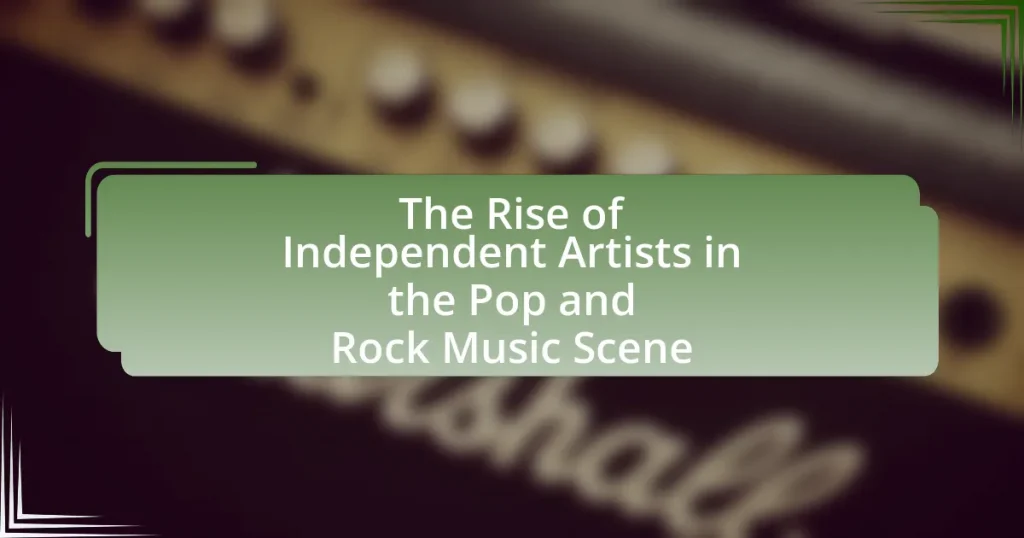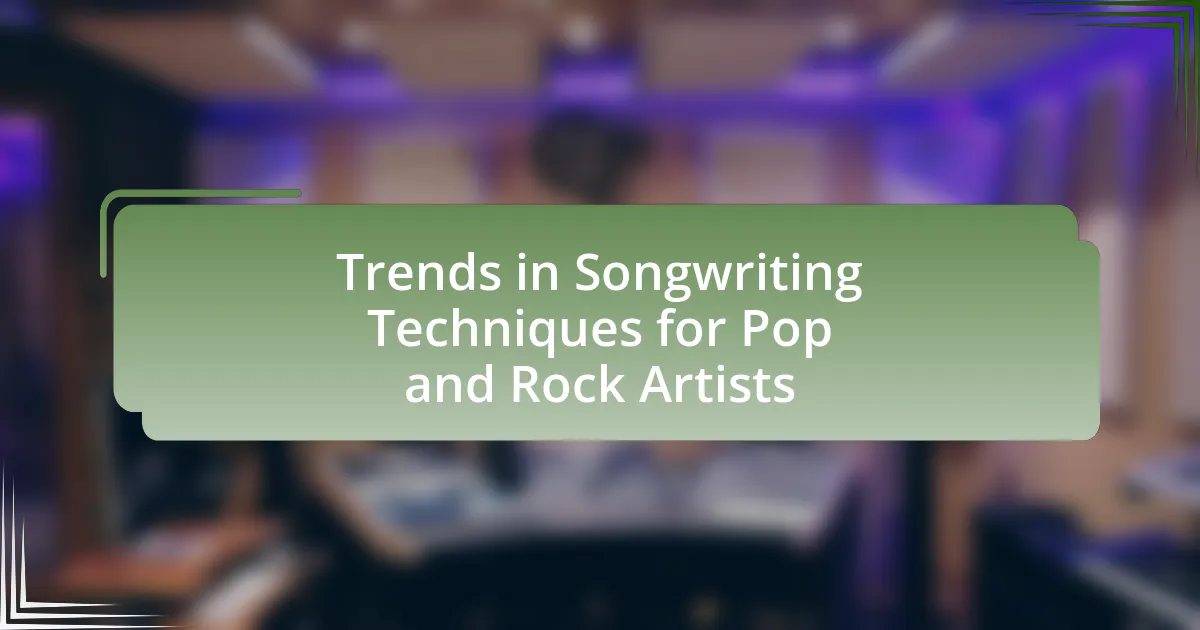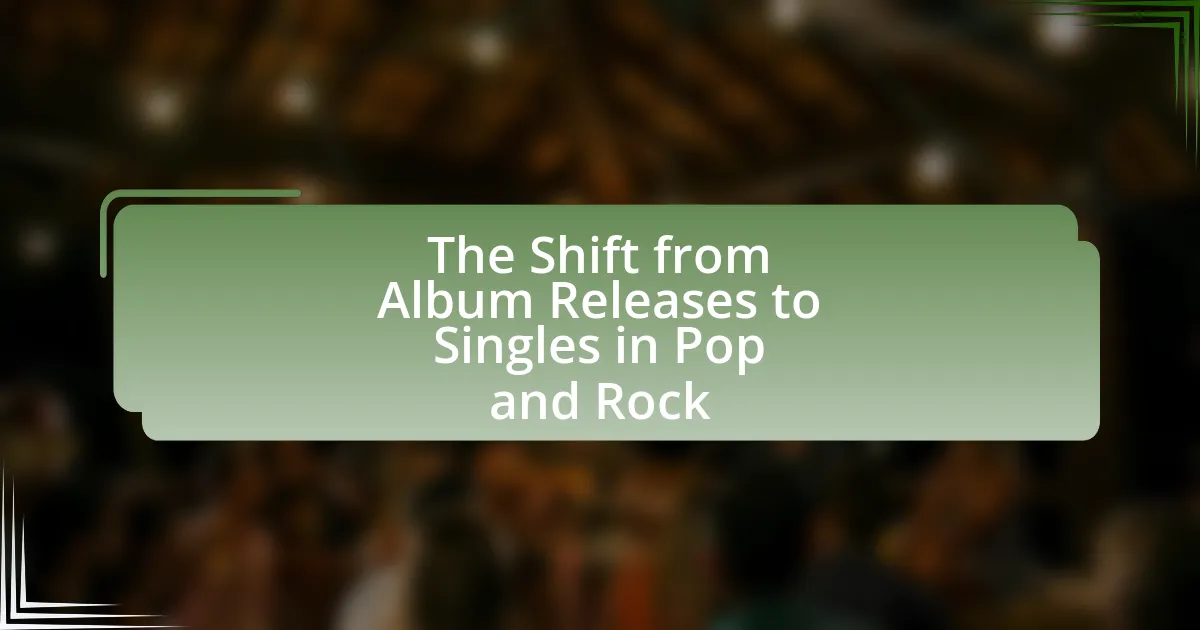The rise of independent artists in the pop and rock music scene highlights the increasing success of musicians operating outside major record labels, driven by advancements in technology and digital distribution platforms. Independent labels accounted for 40% of global recorded music revenues in 2021, showcasing their growing influence. This article explores how the music industry landscape has shifted to favor independent artists, the factors contributing to their growth, the challenges they face, and the impact they have on mainstream music trends and listener preferences. Additionally, it examines the role of technology, marketing strategies, and best practices for aspiring independent artists in building their brand and audience.

What is the Rise of Independent Artists in the Pop and Rock Music Scene?
The rise of independent artists in the pop and rock music scene refers to the increasing prominence and success of musicians who operate outside of major record labels. This trend has been facilitated by advancements in technology, particularly digital distribution platforms like Spotify and Bandcamp, which allow artists to reach global audiences without traditional gatekeepers. According to a 2021 report by the International Federation of the Phonographic Industry, independent labels accounted for 40% of global recorded music revenues, highlighting their significant impact on the industry. Additionally, social media platforms enable artists to build direct connections with fans, further enhancing their visibility and marketability.
How has the landscape of the music industry changed for independent artists?
The landscape of the music industry has significantly shifted in favor of independent artists due to advancements in technology and changes in distribution methods. Independent artists now have access to digital platforms like Spotify, Bandcamp, and SoundCloud, which allow them to distribute their music globally without the need for a traditional record label. According to a 2021 report by the International Federation of the Phonographic Industry (IFPI), independent labels accounted for 40% of global recorded music revenues, highlighting their growing influence. Additionally, social media platforms enable independent artists to build their fanbase and market their music directly, bypassing traditional promotional channels. This democratization of music distribution and promotion has empowered independent artists to achieve commercial success and artistic freedom.
What factors have contributed to the growth of independent artists?
The growth of independent artists has been significantly influenced by advancements in technology, particularly digital distribution and social media. Digital platforms like Spotify and Bandcamp allow artists to distribute their music globally without the need for traditional record labels, enabling greater access to audiences. Social media platforms such as Instagram and TikTok facilitate direct engagement with fans, allowing artists to build their brand and promote their work effectively. Additionally, the decline of major label dominance has created a more level playing field, encouraging diverse voices and innovative sounds in the music industry. According to a report by the International Federation of the Phonographic Industry (IFPI), independent labels accounted for 40% of global recorded music revenues in 2020, highlighting the significant market share and influence of independent artists.
How do independent artists differ from signed artists in the pop and rock genres?
Independent artists differ from signed artists in the pop and rock genres primarily in their level of control and financial backing. Independent artists typically retain full creative control over their music and marketing strategies, allowing them to express their artistic vision without external constraints. In contrast, signed artists often work under record labels that dictate aspects of their music production, promotion, and distribution, which can limit their creative freedom.
Financially, independent artists rely on self-funding, crowdfunding, or small-scale partnerships, while signed artists benefit from the substantial resources and marketing power of their record labels, which can lead to wider exposure and higher production budgets. According to a 2021 report by MIDiA Research, independent artists accounted for 40% of global music revenues, highlighting their growing influence despite having fewer resources compared to signed artists.
Why is the rise of independent artists significant in today’s music scene?
The rise of independent artists is significant in today’s music scene because it democratizes music production and distribution, allowing diverse voices to emerge without the constraints of major labels. Independent artists leverage digital platforms, such as Spotify and Bandcamp, to reach global audiences directly, which has led to a 35% increase in independent music revenue from 2019 to 2021, according to the IFPI Global Music Report. This shift not only fosters innovation and creativity but also challenges traditional industry norms, enabling artists to maintain creative control and connect authentically with their fanbase.
What impact do independent artists have on mainstream music trends?
Independent artists significantly influence mainstream music trends by introducing innovative sounds and diverse genres that challenge traditional industry norms. Their ability to leverage digital platforms allows them to reach wider audiences, often leading to the incorporation of their styles into mainstream music. For instance, the rise of genres like lo-fi hip-hop and bedroom pop, popularized by independent artists on platforms such as SoundCloud and Bandcamp, has prompted major labels to adapt their production and marketing strategies to include these emerging sounds. Additionally, data from the Recording Industry Association of America (RIAA) indicates that independent music accounted for over 30% of U.S. music revenue in 2020, highlighting their growing impact on the market and trends.
How do independent artists influence listener preferences and behaviors?
Independent artists significantly influence listener preferences and behaviors by offering unique, diverse musical styles that challenge mainstream norms. Their ability to connect directly with audiences through social media platforms fosters a sense of community and authenticity, which resonates with listeners seeking genuine experiences. For instance, a study by the University of Southern California found that 70% of music consumers prefer discovering new music through independent artists rather than major labels, indicating a shift in listener behavior towards valuing originality and personal connection over commercial appeal. This trend is further supported by the rise of platforms like Bandcamp and SoundCloud, where independent artists can share their work without the constraints of traditional music industry gatekeepers, thereby shaping listener tastes and preferences in a more personalized manner.
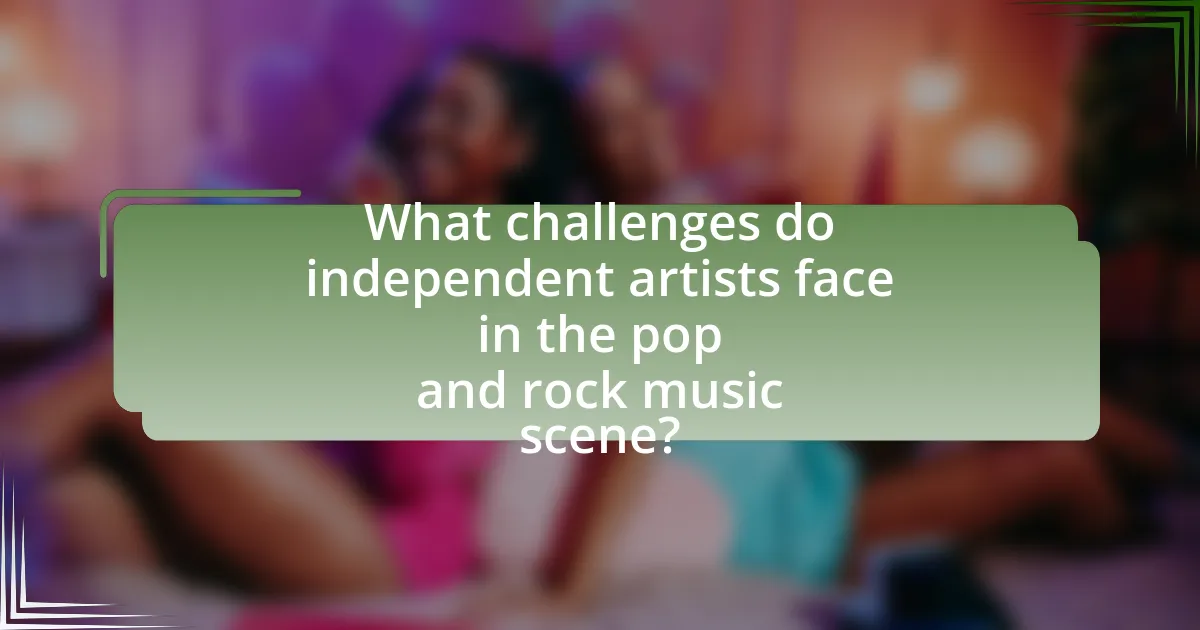
What challenges do independent artists face in the pop and rock music scene?
Independent artists in the pop and rock music scene face significant challenges, including limited financial resources, lack of industry connections, and difficulties in marketing their music. Financial constraints often hinder their ability to produce high-quality recordings and promote their work effectively. Additionally, without established networks, independent artists struggle to secure gigs, collaborations, and media coverage, which are crucial for gaining visibility. Marketing their music in a saturated market poses another challenge, as they must compete with major label artists who have substantial promotional budgets. According to a 2021 survey by the Music Industry Research Association, 70% of independent artists reported that funding and marketing were their top obstacles, highlighting the systemic issues they encounter in the industry.
How do financial constraints affect independent artists?
Financial constraints significantly limit independent artists’ ability to produce, promote, and distribute their work. These limitations often result in reduced access to quality recording equipment, professional production services, and marketing resources, which are essential for reaching wider audiences. For instance, a survey by the Music Industry Research Association found that 70% of independent musicians cite financial barriers as a major obstacle to their career advancement. Consequently, many independent artists struggle to compete with well-funded labels, leading to challenges in gaining visibility and sustaining their artistic endeavors.
What are the common funding sources for independent artists?
Common funding sources for independent artists include crowdfunding platforms, grants, sponsorships, merchandise sales, and music licensing. Crowdfunding platforms like Kickstarter and Indiegogo allow artists to raise money directly from fans, often in exchange for exclusive content or rewards. Grants from arts organizations and government bodies provide financial support for specific projects or general operating costs. Sponsorships from brands can offer financial backing in exchange for promotional opportunities. Additionally, merchandise sales generate revenue directly from fans, while music licensing can provide income through the use of an artist’s music in films, commercials, or video games. These funding sources are essential for independent artists to sustain their careers and produce new work.
How do independent artists manage production and distribution costs?
Independent artists manage production and distribution costs by utilizing low-cost technology and leveraging digital platforms. They often produce music using affordable recording software and home studios, which significantly reduces expenses compared to traditional studio recording. Additionally, independent artists distribute their music through online platforms like Bandcamp, Spotify, and SoundCloud, which eliminate the need for physical distribution and associated costs. According to a 2021 report by the International Federation of the Phonographic Industry, independent labels accounted for 40% of global recorded music revenue, highlighting the effectiveness of these cost management strategies.
What marketing strategies do independent artists employ?
Independent artists employ a variety of marketing strategies to promote their music and build their brand. These strategies include leveraging social media platforms for direct engagement with fans, utilizing digital distribution services to reach wider audiences, and collaborating with other artists to expand their reach. For instance, a 2021 survey by the Music Industry Research Association found that 70% of independent artists use social media as their primary marketing tool, highlighting its effectiveness in connecting with listeners. Additionally, independent artists often engage in grassroots marketing efforts, such as performing at local venues and participating in community events, which fosters a loyal fan base and enhances visibility.
How do social media platforms play a role in promoting independent artists?
Social media platforms significantly promote independent artists by providing them with accessible channels to reach a global audience. These platforms, such as Instagram, TikTok, and Spotify, enable artists to share their music, engage with fans, and build a personal brand without the need for traditional record labels. For instance, TikTok has been instrumental in launching songs into viral hits, with tracks like “Old Town Road” by Lil Nas X gaining popularity through user-generated content. Additionally, a study by the Berklee College of Music found that 70% of independent artists use social media to connect with their audience, highlighting its importance in their marketing strategies. This direct interaction fosters community and loyalty, allowing independent artists to thrive in a competitive music landscape.
What are the most effective ways for independent artists to reach their audience?
Independent artists can effectively reach their audience through social media platforms, live performances, and collaborations. Social media platforms like Instagram, TikTok, and YouTube allow artists to share their music and engage directly with fans, leveraging algorithms that promote organic reach. For instance, TikTok has been instrumental in launching songs into mainstream popularity, with 67% of users discovering new music through the app. Live performances, whether virtual or in-person, create personal connections and foster community, which is crucial for independent artists. Collaborations with other artists or influencers can also expand their audience base, as seen with many independent musicians who gain traction by partnering with more established acts. These methods collectively enhance visibility and engagement, essential for building a loyal fanbase in the competitive music landscape.
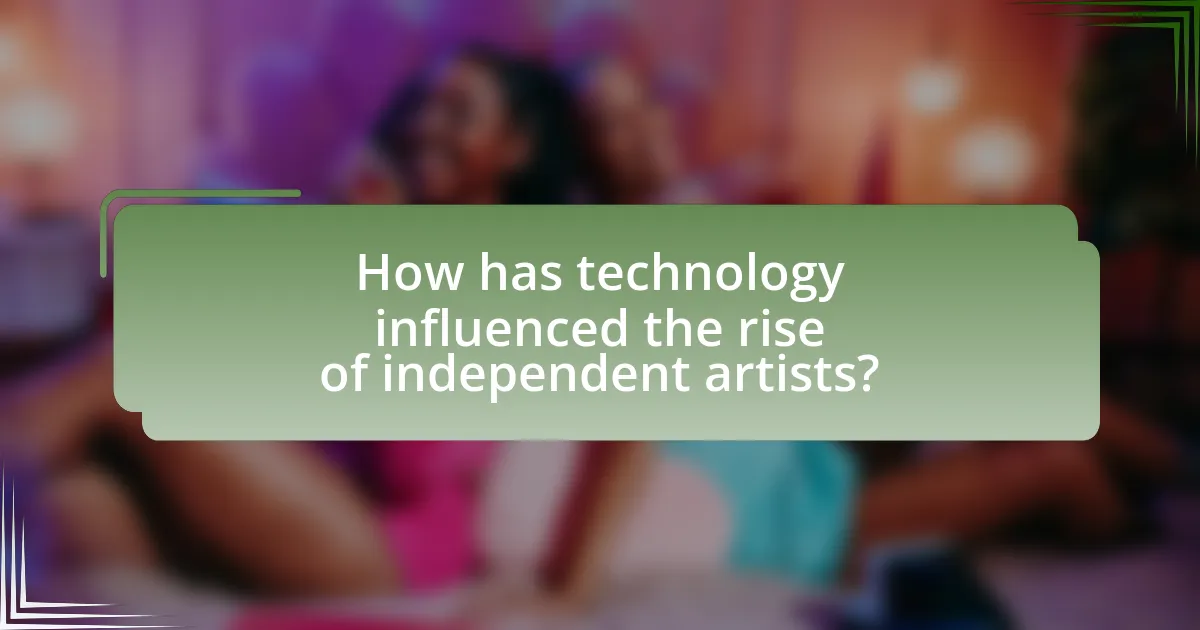
How has technology influenced the rise of independent artists?
Technology has significantly influenced the rise of independent artists by providing accessible platforms for music distribution and promotion. Digital platforms such as Spotify, Bandcamp, and social media enable artists to reach global audiences without the need for traditional record labels. According to a 2021 report by the International Federation of the Phonographic Industry, independent labels accounted for 40% of global recorded music revenue, highlighting the shift towards independent artistry facilitated by technology. Additionally, tools for music production, such as affordable software and home recording equipment, empower artists to create high-quality music independently, further contributing to their rise in the industry.
What role do digital platforms play in the success of independent artists?
Digital platforms are crucial for the success of independent artists as they provide accessible avenues for distribution, promotion, and audience engagement. These platforms, such as Spotify, Bandcamp, and social media, enable artists to reach global audiences without the need for traditional record labels. For instance, a report by the International Federation of the Phonographic Industry (IFPI) in 2021 indicated that 70% of music consumption now occurs through streaming services, highlighting the importance of these platforms in connecting artists with listeners. Additionally, independent artists can leverage social media for direct interaction with fans, fostering a loyal community and enhancing their visibility. This democratization of music distribution and promotion has significantly contributed to the rise of independent artists in the pop and rock music scene.
How do streaming services impact the visibility of independent artists?
Streaming services significantly enhance the visibility of independent artists by providing them with a global platform to reach audiences without the need for traditional record label support. These platforms, such as Spotify and Apple Music, allow independent musicians to upload their music directly, making it accessible to millions of listeners worldwide. According to a 2021 report by the International Federation of the Phonographic Industry, independent labels accounted for 40% of global recorded music revenue, highlighting the growing influence of independent artists facilitated by streaming services. Additionally, algorithms and curated playlists on these platforms often promote independent music, further increasing exposure and listener engagement.
What tools and software are essential for independent artists in music production?
Essential tools and software for independent artists in music production include Digital Audio Workstations (DAWs) like Ableton Live, Logic Pro, and FL Studio, as well as audio interfaces such as Focusrite Scarlett and PreSonus AudioBox. These DAWs provide comprehensive platforms for recording, editing, and mixing music, while audio interfaces enhance sound quality and connectivity with instruments and microphones. Additionally, plugins like Serum and Waves offer sound design and mixing capabilities that are crucial for professional-quality production. According to a 2021 survey by the Music Industry Research Association, 70% of independent artists reported using DAWs as their primary tool for music creation, highlighting their importance in the modern music landscape.
How do independent artists build their brand and identity?
Independent artists build their brand and identity by leveraging social media platforms, engaging directly with their audience, and creating a unique artistic vision. Social media allows these artists to showcase their work, share personal stories, and connect with fans, which fosters a loyal community. For instance, platforms like Instagram and TikTok have become essential tools for independent musicians to promote their music and brand, with TikTok alone generating over 1 billion monthly active users, providing vast exposure opportunities. Additionally, independent artists often differentiate themselves through distinctive visual aesthetics and thematic content, which helps establish a recognizable brand identity. This approach is supported by the fact that artists who maintain a consistent brand across various platforms tend to see higher engagement rates, as noted in studies by the Music Industry Research Association.
What are the key elements of branding for independent artists?
The key elements of branding for independent artists include a unique artistic identity, consistent visual aesthetics, effective storytelling, and audience engagement. A unique artistic identity differentiates the artist from others, allowing them to establish a recognizable presence in the music industry. Consistent visual aesthetics, such as logos, album covers, and social media profiles, create a cohesive brand image that resonates with fans. Effective storytelling through lyrics, interviews, and social media content helps to build a personal connection with the audience, fostering loyalty. Audience engagement, through live performances and interactive online content, strengthens the relationship between the artist and their fans, enhancing brand loyalty and visibility. These elements are essential for independent artists to navigate the competitive landscape of the pop and rock music scene successfully.
How do independent artists create a unique sound that resonates with audiences?
Independent artists create a unique sound that resonates with audiences by blending diverse musical influences and personal experiences into their work. This approach allows them to craft distinctive styles that reflect their individuality, setting them apart from mainstream artists. For instance, many independent musicians utilize unconventional instruments or experimental production techniques, which can lead to innovative soundscapes. Additionally, they often draw inspiration from various genres, resulting in a fusion that appeals to a broader audience. The authenticity of their lyrics, often rooted in personal narratives, further enhances emotional connection with listeners. This combination of originality and relatability is supported by data showing that independent artists frequently achieve higher engagement rates on streaming platforms, indicating a strong resonance with their audience.
What are the best practices for aspiring independent artists in the pop and rock scene?
Aspiring independent artists in the pop and rock scene should focus on building a strong online presence, engaging with their audience, and consistently producing high-quality music. Establishing a professional website and utilizing social media platforms like Instagram, TikTok, and YouTube can significantly enhance visibility and fan engagement. According to a 2021 report by the International Federation of the Phonographic Industry, 70% of music consumers discover new artists through social media, highlighting its importance. Additionally, artists should collaborate with other musicians and producers to expand their network and reach. Regularly releasing music and engaging in live performances, whether virtual or in-person, helps maintain audience interest and loyalty. These practices are essential for navigating the competitive landscape of the music industry and achieving success as an independent artist.
How can independent artists effectively network within the industry?
Independent artists can effectively network within the industry by actively participating in music events, utilizing social media platforms, and collaborating with other artists. Engaging in local music festivals, open mics, and industry conferences allows artists to meet industry professionals and fellow musicians, fostering valuable connections. Social media platforms like Instagram, Twitter, and TikTok enable artists to showcase their work, interact with fans, and connect with industry influencers, which is crucial for visibility. Collaborating with other independent artists not only expands their audience but also creates opportunities for mutual promotion and support. According to a study by the Berklee College of Music, networking is essential for independent artists, as 70% of music industry professionals report that personal connections significantly influence their decisions.
What steps should independent artists take to establish a loyal fan base?
Independent artists should engage with their audience through consistent content creation, social media interaction, and live performances to establish a loyal fan base. By regularly releasing music, videos, and behind-the-scenes content, artists can keep their fans engaged and invested in their journey. Social media platforms like Instagram, Twitter, and TikTok allow artists to communicate directly with fans, fostering a sense of community and personal connection. Additionally, performing live, whether in small venues or virtual concerts, helps artists build a personal rapport with their audience, enhancing loyalty. Research indicates that artists who actively engage with their fans on social media see a 30% increase in fan retention compared to those who do not.
